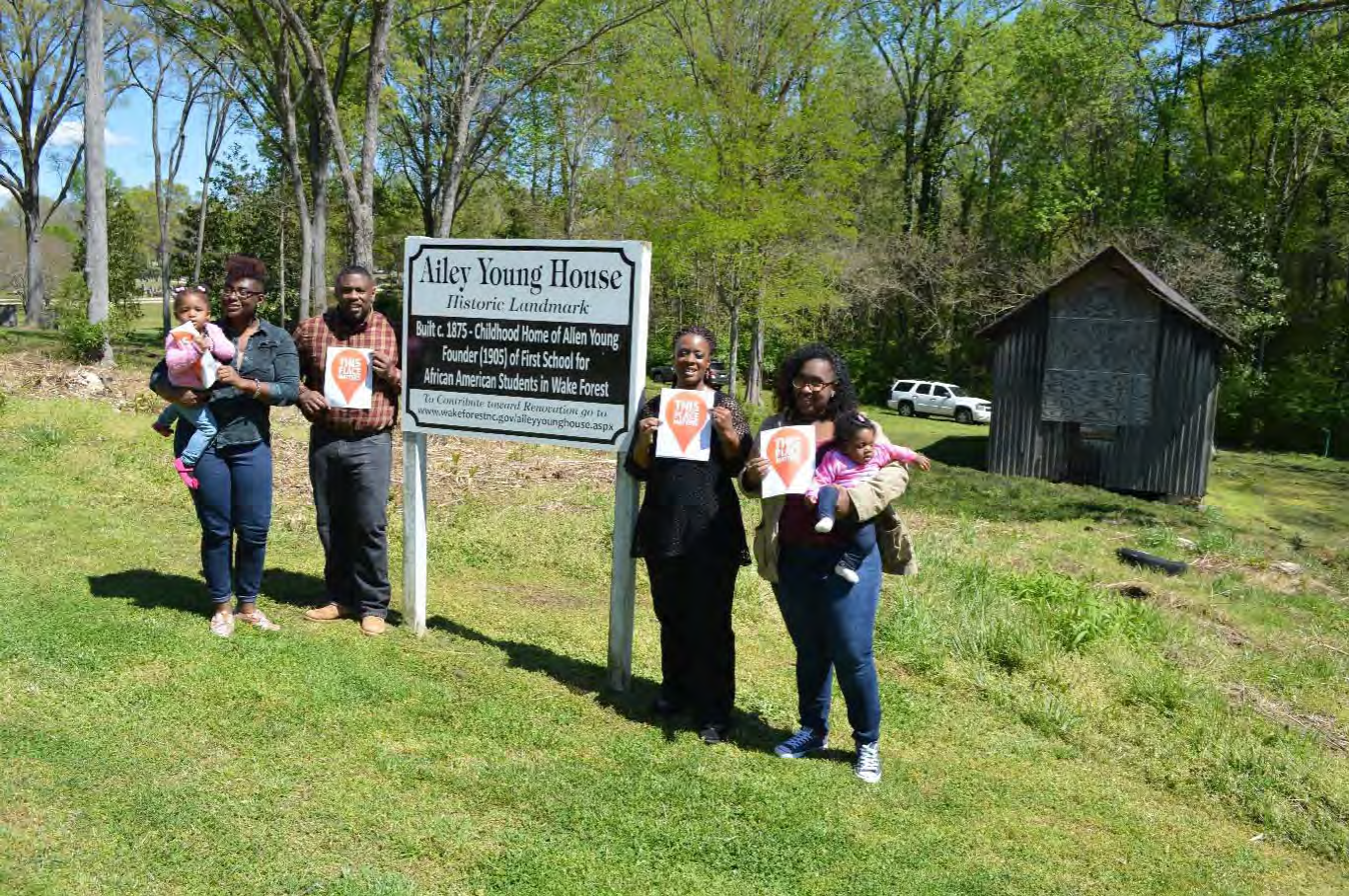Ailey Young House
In 2008, the Town of Wake Forest conducted a Historic Resource Survey update to identify the Town's historic properties constructed before 1958. The survey's most significant find was the Ailey Young House (identified in the survey as the Allen Young House), The historic house coincidentally happened to be located on Town-owned property. As a result of that survey, the Ailey Young House was added to the North Carolina Study List for potentially eligible National Register properties and was designated as a Wake Forest Local Historic Landmark.
Historical Significance
The Ailey Young House may be the oldest remaining African-American historic building in Wake Forest. It has historical significance as a rare example of Reconstruction-era African American architecture, the home of Ailey and Henry Young, and childhood home of Allen Young, a significant citizen and educator in Wake Forest. It is believed that the house was constructed as rental housing by Wake Forest College Professor William G. Simmons and was one of a number of houses along a stretch of N. White Street known as "Simmons Row." These houses appear on the 1915 to 1936 Sanborn Fire Insurance map. After Professor Simmons' death in 1889, his widow, Mary Elizabeth subdivided his land and sold most of it to African American families.
The 1880 census lists Ailey and Henry Young at the N. White Street location and we believe they may have been there as early as 1875. The couple started their marriage and their family in the duplex. In 1895, Ailey Young purchased the house from Mary Elizabeth Simmons. Ailey and Henry's oldest son, Allen, grew up to become a significant citizen and educator in Wake Forest's history. He taught public school in Wake County until 1905 when he and others organized the Presbyterian Mission School for Black Boys and Girls. The name was soon changed to the Wake Forest Normal and Industrial School and was the first private school for Black children in Wake Forest. The school was a thriving private institution in the 1910s and attracted boarding students from northern states in the 1920s and 1930s when over 300 students were enrolled. The opening of a new enlarged public school using Rosenwald Funds in the late 1920s began a reduction in attendance of Young's private school. Allen Young also founded the Spring Street Presbyterian Church for African Americans and operated a dry-cleaning business that catered to Wake Forest College. The last family member to live in the house was Hubert Young, but the home served as a rental and was vacant since the 1970s. It is the only building left to tell the story of Ailey and Henry Young and their family including their son, Allen.
The significance of the Young family continued beyond Allen as his daughter, Ailey Mae Young (named after her grandmother), a schoolteacher, was the first African-American town commissioner and second female commissioner. She was first elected to office in 1971 and re-elected in 1975. The Ailey Mae Young Park is named for her. Ailey Mae and her sister Maude built their home on Spring Street at the site of their father's school. They both lived there until their deaths.

Structural Conditions and Rehabilitation Project
Over the years the house suffered fire damage, lost its windows, doors, and front porch, despite this its quality of construction has allowed it to survive to this day. Original structural elements remain today such as the stone piers, stone chimney base, wide wood sills, and original framing and board-and-batten siding.
The house burned sometime in the 1970s or 1980s. The cause of the fire is unknown. The west end of the house and the attic over both sides was mostly destroyed. The metal roof, board-and-batten siding, original interior woodwork on the east side, and stairs remained intact though smoke damaged. Nature also took its toll on the structure while it sat empty; overtime a tree branch grew to touch and eventually push the roofing service, resulting in several holes that left the chimneys and/or flues open to the elements. The window sashes and doors were also missing leading to several points of access to the interior. However, the foundation, sills, joists, walls, exterior board and batten siding, and central chimney remained in good condition.
In 2012, some of the overgrown brush was removed and the house was secured until funds could be raised for the rehabilitation. Windows and doors were secured and holes in the roof and siding were covered with plywood. In 2015, the Town received a grant from Preservation NC to shore-up the first floor and stabilize the structure. With additional funds from the Historic Preservation Commission, much of the west side was restored matching the original fabric as closely as possible. In 2020 the State of North Carolina provided a grant to complete the rehabilitation of the building. All work was completed meeting the Secretary of Interiors Standards for Rehabilitation. The most recent project was painting the house using traditional linseed oil paint and matching the original paint color dating from Ailey Young's ownership. The Ailey Young House Preservation Manual includes a complete account of the rehabilitation projects.
Architectural Description & Significance
The long abandoned, partially burned 1 ½-story saddlebag house sits on high, fieldstone piers on a lot located on North White Street, north of Spring Street and south of the town cemetery. The saddlebag house consists of two frame pens flanking a very large stone chimney with a brick stack. Large fireplaces served the main room of both pens (rooms/units). In the right front corner of the east pen, a stair ascends to the second floor. A similar stair accessed the second floor on the west pen but was destroyed in the fire. The right pen has horizontal sheathed walls and a mantel. Each pen has a front door that opened onto a porch with a shed roof that has since collapsed. Window openings have lost their sashes with the exception of one 4-pane upper sash surviving on the rear. Evidence suggests some of the larger openings may have held 6-over-6 sashes. The home’s sills and the boards of the walls are circular sawn. Visible nails include square, machine-cut nails, finish nails, and wire nails. Its likely original board-and-batten siding, with beveled battens, is in sound condition.
The saddlebag style house was commonly in use as enslaved housing. This house, however, is a much grander version. It was likely built in the 1870s, or perhaps a little earlier. It is most certainly a rare example of Reconstruction Era post-Civil War housing for the African American working class. According to local restoration carpenter, Patrick Schell, "There's just nothing like this left. The fancier houses tend to survive, but something like this, the housing for regular folks, especially African-Americans, is extremely rare!"
Site Planning and Park Project
The location of the house is set low on the landscape at the edge of a creek known as a "bottom". The damp location and sloped grade above have made the site damp and subject to erosion. The Town recently completed an erosion mitigation project to alleviate the erosion and safeguard the archaeological component of the site. The recently completed Northeast Community Plan recommended that the Town use the Ailey Young House as a heritage site to celebrate the history of the NE Community in Wake Forest and be part of a larger gateway park for the Northeast Community.
Donate Now
If you would like to make a tax exempt donation to this important project, please donate online or send a check made out to the Wake Forest Historic Preservation Commission, write Ailey Young House in the memo line, and mail it to:
Wake Forest Historic Preservation Commission
Town of Wake Forest
301 S. Brooks St.
Wake Forest, NC 27587
